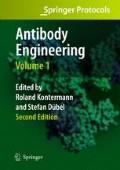While the selection of antibody fragments from large V-gene libraries via phage display and panning permits the efficient enrichment of pools with antigen-binding activity, the successful identification of individual clones with desired binding specificities constitutes another crucial step. The sandwich-filter colony screening assay has proven as a facile and rapid method in particular for the isolation of recombinant Fab fragments with new or improved antigen-binding activities among 103-105 different clones. In this assay, bacterial colonies harbouring plasmids for the periplasmic expression of antibody fragments are grown on a hydrophilic filter membrane on an agar plate. Upon induction, the antibody fragments are functionally secreted into the periplasm and become partially released from the bacterial colonies. After diffusion across the hydrophilic membrane, the recombinant proteins are finally immobilised on a second hydrophobic membrane that is placed underneath and coated with a capturing reagent. Thus, the antibody fragments become functionally immobilised and, subsequently, they can be probed for binding of a labelled antigen. Antigen-binding activity is directly visualised on this second membrane, for example by using an enzyme conjugate followed by a chromogenic reaction. Colonies that give rise to a strong signal are then identified on the first membrane and propagated for further analysis, preparative expression, and/or subcloning of the V-genes. Apart from Fab fragments, this assay can be applied to many other types of bacterially produced antibody fragments as well as to non-immunoglobulin scaffolds with engineered binding properties.
Access this chapter
Tax calculation will be finalised at checkout
Purchases are for personal use only
References
de Wildt RMT, Mundy CR, Gorick BD, Tomlinson IM (2000) Antibody arrays for high-throughput screening of antibody-antigen interactions. Nat Biotechnol 18:989–994
Fiedler M, Horn C, Bandtlow C, Schwab ME, Skerra A (2002) An engineered IN-1 Fab fragment with improved affinity for the Nogo-A axonal growth inhibitor permits immunochemical detection and shows enhanced neutralizing activity. Protein Eng 15:931–941
Gibson TJ (1984) Studies on the Eppstein-Barr virus genome. PhD thesis, Cambridge University, England
Gill SC, von Hippel PH (1989) Calculation of protein extinction coefficients from amino acid sequence data. Anal Biochem 182:319–326
Holliger P, Hudson PJ (2005) Engineered antibody fragments and the rise of single domains. Nat Biotechnol 23:1126–1136
Hoogenboom HR (2005) Selecting and screening recombinant antibody libraries. Nat Biotechnol 23:1105–1116
Kim HJ, Eichinger A, Skerra A (2009) High affinity recognition of lanthanide (III) chelate complexes by a reprogrammed human lipocalin 2. J Am Chem Soc 131:3565–3576
König T, Skerra A (1998) Use of an albumin-binding domain for the selective immobilisation of recombinant capture antibody fragments on ELISA plates. J Immunol Methods 218:73–83
Plückthun A, Skerra A (1989) Expression of functional antibody Fv and Fab fragments in Escherichia coli. Methods Enzymol 178:497–515
Sambrook J, Fritsch EF, Maniatis T (2001) Molecular cloning: a laboratory manual, 3rd edn. Cold Spring Harbor Laboratory Press, Cold Spring Harbor, NY
Schlapschy M, Gruber H, Gresch O, Schäfer C, Renner C, Pfreundschuh M, Skerra A (2004) Functional humanization of an anti-CD30 Fab fragment for the immunotherapy of Hodgkin’s lymphoma using an in vitro evolution approach. Protein Eng Des Sel 17:847–860
Schlehuber S, Beste G, Skerra A (2000) A novel type of receptor protein, based on the lipocalin scaffold, with specificity for digoxigenin. J Mol Biol 297:1105–1120
Schmidt TGM, Skerra A (2007) The Strep-tag system for one-step purification and high affinity detection or capturing of proteins. Nat Protoc 2:1528–1535
Skerra A (1994a) A general vector, pASK84, for cloning, bacterial production, and single-step purification of antibody Fab fragments. Gene 141:79–84
Skerra A (1994b) Use of the tetracycline promoter for the tightly regulated production of a murine antibody fragment in Escherichia coli. Gene 151:131–135
Skerra A, Dreher ML, Winter G (1991) Filter screening of antibody Fab fragments secreted from individual bacterial colonies: Specific detection of antigen binding with a two-membrane system. Anal Biochem 196:151–155
Strauch KL, Beckwith J (1988) An Escherichia coli mutation preventing degradation of abnormal periplasmic proteins. Proc Natl Acad Sci USA 85:1576–1580
Yanisch-Perron C, Vieira J, Messing J (1985) Improved M13 phage cloning vectors and host strains: nucleotide sequences of the M13mp18 and pUC19 vectors. Gene 33:103–119
Author information
Authors and Affiliations
Corresponding author
Editor information
Editors and Affiliations
Rights and permissions
Copyright information
© 2010 Springer-Verlag
About this protocol
Cite this protocol
Rauth, S., Schlapschy, M., Skerra, A. (2010). Selection of Antibody Fragments by Means of the Filter-Sandwich Colony Screening Assay. In: Kontermann, R., Dübel, S. (eds) Antibody Engineering. Springer Protocols Handbooks. Springer, Berlin, Heidelberg. https://doi.org/10.1007/978-3-642-01144-3_17
Download citation
DOI: https://doi.org/10.1007/978-3-642-01144-3_17
Publisher Name: Springer, Berlin, Heidelberg
Print ISBN: 978-3-642-01143-6
Online ISBN: 978-3-642-01144-3
eBook Packages: Springer Protocols

